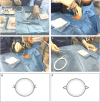Safety of Percutaneous Dilatational Tracheotomy in Patients on Dual Antiplatelet Therapy and Anticoagulation
- PMID: 32166231
- PMCID: PMC7063886
- DOI: 10.1097/CCE.0000000000000050
Safety of Percutaneous Dilatational Tracheotomy in Patients on Dual Antiplatelet Therapy and Anticoagulation
Abstract
Percutaneous dilatational tracheotomy has become a routine procedure in ICUs. However, given the high and steadily growing number of patients receiving anticoagulation, dual antiplatelet therapy, or even a combination of both (also known as "triple therapy"), there are concerns about the safety of the procedure, in particular for critically ill patients with a high risk of bleeding. In this retrospective study, we investigated whether percutaneous dilatational tracheotomy in this high-risk population was associated with elevated procedural complications.
Design: Retrospective single-center study with analysis of all percutaneous dilatational tracheotomies performed in our cardiac ICU from January 2018 to May 2019.
Setting: Munich university hospital's cardiac ICU.
Patients and interventions: A total of 34 patients who underwent percutaneous dilatational tracheotomy according to Ciaglia technique with accompanying bronchoscopy in our cardiac ICU from January 2018 to May 2019 were included. Patients were stratified into clinically relevant risk groups based on anticoagulation and antiplatelet therapy considering standard laboratory coagulation parameters, that is, activated partial thromboplastin time, international normalized ratio, and platelet count with differentiated analysis of procedure-related complications in each risk group until hospital discharge.
Measurements and main results: A total of 34 patients who underwent percutaneous dilatational tracheotomy were included and assigned to five clinically relevant treatment groups: IV unfractionated heparin (prophylactic dosage) (n = 4), IV unfractionated heparin (therapeutic dosage) (n = 4), aspirin and IV unfractionated heparin (therapeutic dosage) (n = 7), dual antiplatelet therapy with IV unfractionated heparin (prophylactic dosage) (n = 5), and dual antiplatelet therapy with IV unfractionated heparin (therapeutic dosage) (n = 14). Three bleedings without surgical intervention or blood transfusion were documented in the whole cohort, but no single bleeding did occur in the triple therapy group. These were exclusively caused by skin bleedings at the immediate puncture site-each of which could be easily treated with one or two single stitches. There were no severe bleeding complications or potentially life-threatening procedure-related complications. Additionally, the rate of complications in patients with elevated body mass index was not increased.
Conclusions: Bronchoscopy-guided percutaneous dilatational tracheotomy according to Ciaglia technique with careful consideration of all potential indications and contraindications may be a safe and low-complication procedure for airway management, even in patients receiving dual antiplatelet therapy and therapeutic anticoagulation simultaneously in our cohort with a high risk of bleeding.
Keywords: airway management; anticoagulation; antiplatelet therapy; bleeding; percutaneous dilatational tracheotomy.
Copyright © 2019 The Authors. Published by Wolters Kluwer Health, Inc. on behalf of the Society of Critical Care Medicine.
Conflict of interest statement
The authors have disclosed that they do not have any potential conflicts of interest.
Figures

Similar articles
-
Percutaneous dilatational tracheotomy in high-risk ICU patients.Ann Intensive Care. 2021 Jul 28;11(1):116. doi: 10.1186/s13613-021-00906-5. Ann Intensive Care. 2021. PMID: 34319491 Free PMC article.
-
Endoscopic percutaneous dilatational tracheotomy: a prospective evaluation of 500 consecutive cases.Laryngoscope. 2005 Oct;115(10 Pt 2):1-30. doi: 10.1097/01.MLG.0000163744.89688.E8. Laryngoscope. 2005. PMID: 16227862 Review.
-
Coagulation disorders do not increase the risk for bleeding during percutaneous dilatational tracheotomy.Thorac Cardiovasc Surg. 2013 Apr;61(3):234-9. doi: 10.1055/s-0032-1322608. Epub 2013 Jan 23. Thorac Cardiovasc Surg. 2013. PMID: 23344764
-
Percutanous dilatational tracheotomy in the ICU: a Norwegian survey focusing on perceived risk and safety attitudes.Eur J Anaesthesiol. 2008 Nov;25(11):925-32. doi: 10.1017/S0265021508004791. Epub 2008 Jun 26. Eur J Anaesthesiol. 2008. PMID: 18578955
-
[Ciaglia percutaneous dilatation tracheotomy with endoscopic control. Analysis of complication-fraught steps].HNO. 1998 Jul;46(7):678-83. doi: 10.1007/s001060050294. HNO. 1998. PMID: 9736943 Review. German.
Cited by
-
[Bone marrow transplantation patients in the intensive care unit].Med Klin Intensivmed Notfmed. 2021 Mar;116(2):111-120. doi: 10.1007/s00063-021-00782-8. Epub 2021 Feb 9. Med Klin Intensivmed Notfmed. 2021. PMID: 33564899 Free PMC article. Review. German.
-
Liberation From Mechanical Ventilation in the Cardiac Intensive Care Unit.JACC Adv. 2023 Jan 27;2(1):100173. doi: 10.1016/j.jacadv.2022.100173. eCollection 2023 Jan. JACC Adv. 2023. PMID: 38939038 Free PMC article. Review.
-
Tracheostomy in Adult Intensive Care Unit: An ISCCM Expert Panel Practice Recommendations.Indian J Crit Care Med. 2020 Jan;24(Suppl 1):S31-S42. doi: 10.5005/jp-journals-10071-G23184. Indian J Crit Care Med. 2020. PMID: 32205955 Free PMC article.
-
Percutaneous dilatational tracheotomy in high-risk ICU patients.Ann Intensive Care. 2021 Jul 28;11(1):116. doi: 10.1186/s13613-021-00906-5. Ann Intensive Care. 2021. PMID: 34319491 Free PMC article.
-
Antiplatelet and anticoagulation use and risk of bleeding from percutaneous dilatational tracheostomy insertion: Systematic review and meta-analysis.J Intensive Care Soc. 2025 Feb 3;26(2):172-182. doi: 10.1177/17511437251314298. eCollection 2025 May. J Intensive Care Soc. 2025. PMID: 39911516 Free PMC article.
References
-
- Rosseland LA, Laake JH, Stubhaug A. Percutaneous dilatational tracheotomy in intensive care unit patients with increased bleeding risk or obesity. A prospective analysis of 1000 procedures. Acta Anaesthesiol Scand 201155835–841 - PubMed
-
- De Leyn P, Bedert L, Delcroix M, et al. ; Belgian Association of Pneumology and Belgian Association of Cardiothoracic Surgery Tracheotomy: Clinical review and guidelines. Eur J Cardiothorac Surg 200732412–421 - PubMed
-
- Kost KM. Endoscopic percutaneous dilatational tracheotomy: A prospective evaluation of 500 consecutive cases. Laryngoscope 20051151–30 - PubMed
-
- Deppe AC, Kuhn E, Scherner M, et al. Coagulation disorders do not increase the risk for bleeding during percutaneous dilatational tracheotomy. Thorac Cardiovasc Surg 201361234–239 - PubMed
-
- Rumbak MJ, Newton M, Truncale T, et al. A prospective, randomized, study comparing early percutaneous dilational tracheotomy to prolonged translaryngeal intubation (delayed tracheotomy) in critically ill medical patients. Crit Care Med 2004321689–1694 - PubMed
LinkOut - more resources
Full Text Sources

